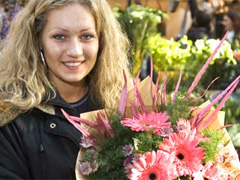


The market took its name from the area that surrounded it, which in turn was so-called because of St. Mary’s Spittel, a hospital and priory founded in 1197 and no longer standing. It may come as a surprise that many landmarks of the area have been around for centuries – the Truman Brewery opened in 1669, and the market itself began on the site in 1666, on a piece of land that was just outside the city gates at the time and had previously been used as grazing land for cattle. After the Great Fire of London the market was made official by King Charles II, and it began operating on Thursdays and Saturdays in and around Spital Square, initially providing fruit and vegetables.
The market was a great success, and it began to attract immigrants who settled here to make a living out of the area’s burgeoning commerce, in particular the French Huguenots who brought with them the silk trade. The now uber-fashionable Fournier Street (home to British artists Gilbert and George and Tracey Emin) was home to a large Huguenot community - the street itself is named after refugee George Fournier - and the bright attic rooms on the second floors of the buildings were ideal for the local weavers. The silk sold at Spitalfields Market became a symbol of luxury; Mozart is said to have bought himself a silk waistcoat from here. \n\nThe development of London’s docks meant that trade opened up with the Far East and India, and it became possible to acquire cheaper silk from elsewhere. The Huguenots swiftly moved on to America to be replaced by Irish immigrants, who moved here in the 1840s during the Irish potato famine, most of whom took to work on the docks. As London expanded rapidly during the Victorian era leading to problems with overcrowding, the market and the surrounding areas fell into decline, much like the rest of the East End, which earned itself the reputation of being one of the most poverty-stricken, crime-ridden parts of the capital. Despite this the market continued to run each week. A sizeable Jewish community moved here over the next few decades - Spitalfields became arguably the largest Jewish area in Europe from the late 19th century until the 1970s - and started work in the “rag trade”, in other words tailoring and dressmaking; indeed this part of London has always had a close affiliation with fashion.
In 1875 the site was bought by Robert Horner, a former market porter. He is responsible for the glass and iron roof that now covers the market, sheltering it from the elements. The Corporation of the City of London then purchased the freehold in the early part of the 20th century and set about extending it.
Thankfully the market managed to survive World War II despite the incessant bombing of the East End, and market traders put together enough money to (rather appropriately) buy a Spitfire fighter plane which they called the ‘Fruitation’. The post-war years saw Bangladeshi families moving to Spitalfields, who subsequently took over the textile trade as the Jewish inhabitants moved out to neighbourhoods like Stamford Hill and Golders Green. Each wave of immigration to the area has brought with it a new cuisine, and there is no doubt that the local bagel shops, curry houses and fish and chip eateries - which now vie for attention alongside the inevitable branches of Gourmet Burger Kitchen and Giraffe located within the market – are a vital part of Spitalfields life.
\n\nIn keeping with much of Britain’s industry, the market would once again fall into private hands in 1987. Expansion of the market resulted in heavy traffic congestion, so in 1991 it was moved out of the city and to suburban Leyton, calling itself New Spitalfields Market. On the new premises fruit, vegetables, flowers, and supplies for catering companies are sold; the sheer number of wholesale traders makes it one of the best markets of its kind in Europe. Meanwhile back at its old location, Old Spitalfields Market continues its trade, but has swapped the fresh produce for vintage clothes, jewellery, art works, antiques and other decorative objects that make it a popular visitor’s destination at the weekends. The busiest days are Thursdays, when the focus is on antiques, Fridays, which are the best days for picking up both vintage and new garments, and Sundays, when you might need to sharpen your elbows to be able to get to the wares on display. The market is closed on Saturdays but that is set to change by the end of 2011.
The transformation of Spitalfields Market from local fruit and veg supplier to fashionista favourite reflects the changing nature of Spitalfields itself – the area has been hugely gentrified in the last 20 years and is now home to chic boutiques, expensive coffee shops and hoards of fashion slaves. The influx of tourists and well-to-do passers-by have even led to the Metropolitan Police deeming certain streets “Good Behaviour Zones” to avoid discouraging any potential visitors to this East London treasure trove (and yes, that is as ludicrous as it sounds, as it means the police may stop anyone they think might be about to do something naughty). If further proof were needed of its hip status, check out some of the events that take place here, which range from vintage fairs to graffiti workshops where you can learn to draw your name in graffiti-style lettering. Just don’t do it in a Good Behaviour Zone.


